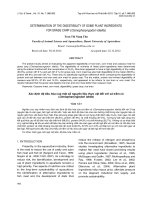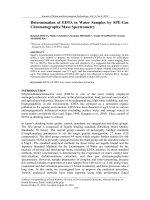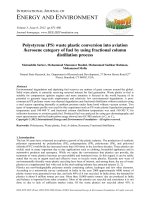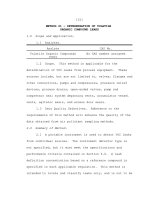Spectrophotometric determination of procainamide hydrochloride using sodium periodate
Bạn đang xem bản rút gọn của tài liệu. Xem và tải ngay bản đầy đủ của tài liệu tại đây (665.23 KB, 5 trang )
REVIEW
Spectrophotometric determination of procainamide
hydrochloride using sodium periodate
S. Al-Tamrah
*
, S. Al-Abbad
Chemistry Department, College of Science, King Saud University, P.O. Box 2455, Riyadh 11451, Saudi Arabia
Received 26 October 2011; accepted 11 February 2012
Available online 20 February 2012
KEYWORDS
Procainamide hydrochloride;
Sulfuric acid;
Sodium periodate;
Spectrophotometry
Abstract A simple spectrophotometric method has been described for the determination of pro-
cainamide hydrochloride. The method is based on the oxidation of procainamide hydrochloride
by sodium periodate in the presence of sulfuric acid and measurement of the absorbance of the vio-
let color formed at 531 nm. Parameters affecting the reaction were studied and conditions were opti-
mized. Linear calibration graph was obtained from 50 to 700 lgml
À1
of procainamide
hydrochloride and the limit of detection was 25 lgml
À1
. The method was successfully applied
for the determination of procainamide hydrochloride in pharmaceutical preparation.
ª 2013 Production and hosting by Elsevier B.V. on behalf of King Saud University.
Contents
1. Introduction . . . . . . . . . . . . . . . . . . . . . . . . . . . . . . . . . . . . . . . . . . . . . . . . . . . . . . . . . . . . . . . . . . . . . . . . . . . 610
2. Experimental. . . . . . . . . . . . . . . . . . . . . . . . . . . . . . . . . . . . . . . . . . . . . . . . . . . . . . . . . . . . . . . . . . . . . . . . . . . 610
2.1. Apparatus. . . . . . . . . . . . . . . . . . . . . . . . . . . . . . . . . . . . . . . . . . . . . . . . . . . . . . . . . . . . . . . . . . . . . . . . 610
2.2. Reagents. . . . . . . . . . . . . . . . . . . . . . . . . . . . . . . . . . . . . . . . . . . . . . . . . . . . . . . . . . . . . . . . . . . . . . . . . 610
3. Optimization of conditions. . . . . . . . . . . . . . . . . . . . . . . . . . . . . . . . . . . . . . . . . . . . . . . . . . . . . . . . . . . . . . . . . 610
4. Calibration graph . . . . . . . . . . . . . . . . . . . . . . . . . . . . . . . . . . . . . . . . . . . . . . . . . . . . . . . . . . . . . . . . . . . . . . . 611
5. Application. . . . . . . . . . . . . . . . . . . . . . . . . . . . . . . . . . . . . . . . . . . . . . . . . . . . . . . . . . . . . . . . . . . . . . . . . . . . 611
6. Discussion . . . . . . . . . . . . . . . . . . . . . . . . . . . . . . . . . . . . . . . . . . . . . . . . . . . . . . . . . . . . . . . . . . . . . . . . . . . . 612
Acknowledgment . . . . . . . . . . . . . . . . . . . . . . . . . . . . . . . . . . . . . . . . . . . . . . . . . . . . . . . . . . . . . . . . . . . . . . . . 613
References . . . . . . . . . . . . . . . . . . . . . . . . . . . . . . . . . . . . . . . . . . . . . . . . . . . . . . . . . . . . . . . . . . . . . . . . . . . . . 613
*
Corresponding author.
E-mail address: (S. Al-Tamrah).
Peer review under responsibility of King Saud University.
Production and hosting by Elsevier
Arabian Journal of Chemistry (2015) 8, 609–613
King Saud University
Arabian Journal of Chemistry
www.ksu.edu.sa
www.sciencedirect.com
1878-5352 ª 2013 Production and hosting by Elsevier B.V. on behalf of King Saud University.
/>1. Introduction
Procainamide hydrochloride (1) is an antiarrhythmic reagent
which is used to treat cardiac arrhythmic occurring in patients
with heart disease.
Many methods have been used for the determination of
procainamide hydrochloride such as gas chromatography
(Ludden et al., 1978), HPLC using ion exchange resin (Shah-
deo et al., 1997), reversed phase liquid chromatography (Coyle
et al., 1987), thin layer chromatography (Wesley-Hadzija and
Mattocks, 1977), and titrimetry using perchloric acid in the
presence of mercuric acetate (Dunham, 1974).
Various spectrophotometric reagents have been used for the
determination of procainamide hydrochloride. Bratton–
Marshall reagent (1-naphthyl ethylene diamine) which forms
colored product (Klitgaard, 1976), 4-dimethyl amino cinna-
maldehyde forms a schiff base which can be measured at
542 nm was applied for the determination of procainamide
hydrochloride in drugs (Tan et al., 1979), naphthoquinone 4-
sulfonic acid gave colored products with linearity from 50 to
250 lgml
À1
of procainamide hydrochloride (Gurkan, 1989),
copper II ions which form a complex measurable at 380 nm
(Whitaker and Hoyt, 1984), 2-amino phenol forms a red color
compound with procainamide hydrochloride in the presence of
potassium iodate, the method was applied to the analysis of
tablets and injectable samples by measuring the absorbance
at 520 nm (Sastry et al., 1985), tetracyanoquinodimethane
forms a yellow product in the alkaline medium which can be
measured for the determination of procainamide hydrochlo-
ride (Mohamed et al., 1991), and potassium dichromate in
the presence of sulfuric acid forms a red color which can be
measured at 402 nm (Al-Sharkawy, 1991).
Flow injection analysis has been used for the determination
of procainamide hydrochloride using ceric sulfate (Sultan and
Suliman, 1993), the reaction takes place in the presence of sul-
furic acid and the absorbance of product was measured at
480 nm.
A brown product was obtained when p-benzoquinone was
added to procainamide hydrochloride in the presence of so-
dium dihydrogen orthophosphate and the absorbance was
measured at 501 nm (Al-Tamrah and Al-Abbad, 2004).
Periodate is one of the most important oxidizing agents, it
has been used for the determination of many organic and inor-
ganic compounds. The most important application of periodate
is that of malaprade reaction (Malaprade, 1926). Various spec-
trophotometric methods of analysis involving periodate oxida-
tions have been developed. The periodate oxidation of
manganese II to permanganate in acidic medium followed by
detection at 521 nm was used for the determination of manga-
nese in copper-selenide (Emarkova and Podgornaya, 1989), par-
acetamol was determined in pharmaceutical preparation after
the oxidation with periodate in sulfuric acid medium by measur-
ing the absorbance of the yellow product at 410 nm (Al-Tamrah,
1987), Fe(III)[Fe(CN)
6
] complex formed by the oxidation of
Fe(II) with periodate in the presence of potassium ferrocyanide
to give the intense Prussian blue color was used for its determi-
nation ( Rahim and Bashir, 1984), ribavirin was determined after
oxidation by periodate and measurement of the absorbance at
475 nm (Darwish et al., 2006) Periodate oxidation of methoxa-
mine followed by photometric detection at 352 nm was used
for the determination of methoxamine in drugs (Hassan et al.,
2000). The periodate oxidation to phenothiazine drug followed
by detection of the produced semiquinoid radicals at 500–
525 nm (Basavaiah et al., 2000) and the determination of cate-
chol amine in drugs after oxidation with periodate and coupling
with p-toluidine and measurement of the orange product at
480 nm (Abdulrahman et al., 2005), are also another examples
of periodate applications.
2. Experimental
2.1. Apparatus
All the absorbance spectral measurements were made using
UV–vis spectrum Lambda 2S[Perkin–Elmer] with 10 nm
quarts cell.
2.2. Reagents
All chemical reagents are of analytical grade.
a- Procainamide hydrochloride solution (Aldrich UK)
1000 lgml
À1
was prepared by dissolving 1 g in double
distilled water with shaking for 5 min and completing
the volume to 1 l with double distilled water.
b- Sulfuric acid
1 M solution of sulfuric acid (Analar BDH, 95–97%)
was prepared by dissolving 27 ml in 300 ml of double
distilled water and completing the volume to 500 ml with
double distilled water.
c- Sodium periodate
1% solution of sodium periodate (Merck Germany) was
prepared by dissolving 1 g in 100 ml of double distilling
water.
d- Pronstyl, 250 mg tablets (Squibb England) was supplied
from King Fahad Hospital.
When sodium periodate is added to procainamide hydro-
chloride, a pale yellow color is formed probably due to the oxi-
dation of the amino group, the intensity of this color is related
to the concentration of procainamide hydrochloride but
cannot be used because the absorbance is very weak. The addi-
tion of sulfuric acid to procainamide hydrochloride and heat-
ing followed by sodium periodate, a violet color is obtained
which can be measured at 531 nm as shown in Fig. 1.
3. Optimization of conditions
Many parameters affect the reaction and must be studied these
include:
Sulphuric acid: Sulfuric acid has an important effect on the
hydrolysis of procainamide hydrochloride and the formation
of p-aminobenzoic acid. When the mixture was heated and
610 S. Al-Tamrah, S. Al-Abbad
periodate was added the absorbance was found to increase
with sulfuric acid concentration until 0.1 M as shown in Fig. 2.
Sodium periodate: Sodium periodate oxidizes p-aminoben-
zoic acid, the product of procainamide hydrochloride hydroly-
sis in the acidic medium. Different concentrations of sodium
periodate from 0.001 to 0.03 M were added to a solution of
200 lgml
À1
procainamide hydrochloride in the presence of
0.1 M sulfuric acid. The mixture was heated at 50 °C for
5 min and the absorbance was measured at 531 nm. 0.025 M
sodium periodate gave the highest absorbance as shown in
Fig. 3.
Temperature: Temperature affects the reaction of periodate
with procainamide hydrochloride in the presence of sulfuric
acid. The effect of temperature was studied from 25 to
100 °C, the absorbance was found to increase with temperature
up to 80 °C and then remains constant as illustrated in Fig. 4.
Heating time: The time needed for the reaction to complete
was studied. The reagents were mixed and heated at 80 °C
from 1 to 25 min. The absorbance was found to increase with
heating time until 7 min. which was found to be enough for the
reaction to complete as shown in Fig. 5.
Table 1 summarizes the optimal conditions for the reaction
of periodate with procainamide hydrochloride in the presence
of sulfuric acid.
4. Calibration graph
At the optimized conditions, a linear calibration graph was ob-
tained from 50 to 700 lgml
À1
of procainamide hydrochloride
with correlation coefficient of 0.999. The standard deviation
was 0.027 and the limit of detection was 25 lgml
À1
as shown
in Fig. 6.
5. Application
The method was applied to the determination of procainamide
hydrochloride on Pronstyl tablets. Ten tablets were accurately
Figure 1 (a) The spectrum of procainamide hydrochloride against a blank of double distilled water. (b) Absorption spectrum of the
product of the reaction of procainamide hydrochloride with sodium periodate in the presence of sulfuric acid against the blank (sulfuric
acid and sodium periodate).
Figure 2 Effect of sulfuric acid on the absorbance of the
product.
Figure 3 Effect of sodium periodate concentration on the
absorbance.
Spectrophotometric determination 611
weighed and an amount equivalent to 250 mg procainamide
hydrochloride was dissolved in 600 ml double distilled water,
the solution was heated for 5 min at 50 °C to complete disso-
lution. The sample was filtered and the volume was completed
to 1 l with double distilled water to give a final concentration
of 250 lgml
À1
of procainamide hydrochloride.
One milliliter of the sample was transferred to a 10 ml vol-
umetric flask followed by 1 ml of 1 M sulfuric acid, the sample
was heated for 7 min at 80 °C and then cooled to room temper-
ature, 3 ml of sodium periodate (0.08 M) was added and the
volume was completed to the mark with double distilled water.
The absorbance was measured at 531 nm against the blank
(H
2
SO
4
+ NaIO
4
). Very good results were obtained as shown
in Table 2.
6. Discussion
The hydrolysis of procainamide hydrochloride in the presence
of sulfuric acid with heating has been discussed in the literature
and was proved by HPLC, when the solution of procainamide
hydrochloride was injected, one peak was obtained, However,
in the presence of sulfuric acid, two peaks were obtained, the
injections of p-aminobenzoic acid solution gave one peak sim-
ilar to the first peak of procainamide hydrochloride acidic
solution which confirms the hydrolysis of procainamide hydro-
chloride in acidic solution to the corresponding p-aminoben-
zoic acid ( Al-Sharkawy, 1991) as shown in the equation below:
Figure 4 Effect of temperature on the hydrolysis of procain-
amide hydrochloride.
Figure 5 Effect of heating time on the reaction.
Table 1 Optimal conditions for the reaction of periodate with
procainamide hydrochloride in the presence of sulfuric acid.
Sodium periodate 0.025 M
Sulfuric acid 0.1 M
Temperature 80 °C
Heating time 7 min
k
max
531 nm
Figure 6 Calibration graph for procainamide hydrochloride
using sodium periodate.
Table 2 Determination of procainamide hydrochloride in
Pronstyl tablets using sodium periodate.
Sample No. Procainamide hydrochloride (lgml
À1
)
Expected Found
1 25 24.98
2 25 25.44
3 25 25.12
4 25 24.92
5 25 25.01
612 S. Al-Tamrah, S. Al-Abbad
When sodium periodate is added it oxidizes p-aminoben-
zoic acid and violet color appears which turns quickly to
brown. The same color can be obtained when periodate is
added directly to p-aminobenzoic acid. The mechanism of
the oxidation of p-aminobenzoic acid with periodate can be
shown in the equations below:
An intermediate product is formed called nitrene, when two
nitrenes combined they form azobenzene, 4-4
0
-dicarboxylic
acid which gives the violet color (Srivastava et al., 1980).
The absorbance of the violet color formed is related to the
concentration of procainamide hydrochloride and should be
measured within 5 min as the color fades quickly because of
the degradation of the azo compound. The method is very sim-
ple, cheap and can be applied to the analysis of procainamide
hydrochloride in pharmaceutical preparations.
Acknowledgment
The authors extend their appreciation to the deanship of scien-
tific research at King Saud University for funding this work.
References
Abdulrahman, L.K., Al-Abachi, A.M., Al-Qaissay, M.H., 2005. Anal.
Chim. Acta 538 (1–2), 331.
Al-Sharkawy, N.J. 1991. The mechanism and kinetic determination of
procainamide in drug formulation using various oxidants, M. Sc.
Thesis, King Saud University.
Al-Tamrah, S.A., 1987. Orient. J. Chem. 3 (2), 145.
Al-Tamrah, S.A., Al-Abbad, S.H., 2004. J. Saudi Chem. Soc. 8 (3),
385.
Basavaiah, K., Manjunatha, S., Swamy, J., Krishnamurthy, G., 2000.
Anal. Lett. 331, 43.
Coyle, J.D., Mackichan, J.J., Boudolas, H., Lima, J.J., 1987. J. Pharm.
Sci. 76, 402.
Darwish, I.A., Khedr, A.S., Askal, H.F., Mohamed, R.M., 2006. J.
AOAC Int. 892, 341.
Dunham, E., 1974. J. Pharm. Sci. 63 (10), 1645.
Emarkova, L.V., Podgornaya, V.A., 1989. Ind. Lab. 549, 995.
Gurkan, T., 1989. J. Fac. Pharm. Inst. 18, 116.
Hassan, E.M., Abdine, H.H., Al-Obaid, A.R., 2000. Spectrosc. Lett.
331, 9.
Klitgaard, N.A., 1976. J. Arch. Pharm. Chem. Sci. 4, 361.
Ludden, T.M., Lalka, D., Wyman, M.G., Goldreyer, B.N., Haegele,
K.D., Brooks, D.T., Davila, I., Wallace, J.E., 1978. J. Pharm. Sci.
67, 371.
Malaprade, L., 1926. Bull. Soc. Chim. (France) 39 (4), 325.
Mohamed, A.M., Hassan, H.Y., Mohamed, H.A., Hussein, A.A.,
1991. J. Pharm. Biomed. Anal. 9 (7), 525.
Rahim, S.A., Bashir, W.A., 1984. Microchem. J. 291, 87.
Shahdeo, K., March, C., Karnes, H.T., 1997. Anal. Chem. 69 (20),
4278.
Sastry, C.S., Kumari, P.L., Rao, B.G., 1985. Chem. Anal. 30 (3), 461.
Sultan, S.M., Suliman, F.E.O., 1993. Talanta 40 (50), 623.
Tan, H.S., Doepker, J.M., Chia, S.K., 1979. Asian J. Pharm. Sci. 1, 51.
Whitaker, J.E., Hoyt, A.M., 1984. J. Pharm. Sci. 73, 1184.
Wesley-Hadzija, B., Mattocks, A.M., 1977. J. Chromatogr. 143, 307.
Spectrophotometric determination 613









